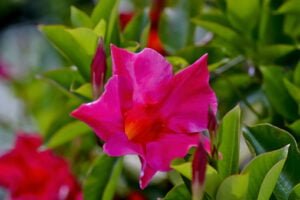Rio Dipladenia Plant
Rio Dipladenia is a hardy plant for warm climates. It can also be kept indoors over the winter. Dipladenia is a blooming evergreen plant that belongs to the Apocynaceae family (Dogbane). These flowering tropical vines are native to Brazil, notably Rio de Janeiro, and can be found across South and Central America, the Southwest United States, the Caribbean, and Mexico.

Dipladenia sanderi is the most common species (Mandevilla sanderi). It’s a woody climber with elliptic, opposite leaves, trumpet-shaped pink blooms, and an orange throat. Dipladenia flowering plants are an excellent choice for your garden or houseplant because of their brilliant, colorful appearance and beautiful growing pattern. Due to its tropical origin, it may flower for the majority of the year, even in temperate climates.
Visit: https://mianfarms.com/sycamore-tree-balls/
However, it will flower for a shorter amount of time at these temperatures. Dipladenia bush grows upwards to a certain point before drooping over the sides of potted plants or hanging baskets and trailing downwards. By providing support at the base and pinching out new growth, you can train your plant to grow in a bushy manner.
Encourage the plant’s climbing behavior by winding it around a taller structure, such as a trellis, as it grows. Rios have trumpet-shaped blooms in white, pink, and deep red. They thrive when exposed to four or more hours of direct sunshine per day.
- Rios can withstand both heat and drought.
- They thrive in both dry and humid environments.
- Low-maintenance and simple-to-care-for.
- All season long, there are beautiful blossoms.
- In containers and gardens, this plant is ideal.
- Rios can be grown indoors throughout the winter months.
Rio Dipladenia is a low-maintenance plant that blooms all season. These lovely tropical plants look great in pots, hanging baskets, and garden beds.
Flower and Fragrance of Rio Dipladenia
Dipladenia Rio plants are bushy plants with small, pointy green leaves that have a subtle sheen and are a deep green color. Compared to Mandevilla flowers, which bloom in a spectrum of colors from pink-red to orange and have a gentle aroma, it has smaller, tube-shaped blossoms.
Temperature and Light
Rock trumpet plants do not mind being in direct sunlight. They will, however, benefit from a light shade over direct sunshine in severely hot conditions. Keep Dipladenia flowers in a sunny window when growing them indoors.
It is not a hardy plant in the cold. It necessitates nightly temperatures between 65 and 70 degrees Fahrenheit. If the weather drops too low, it might be overwintering indoors.
Feeding and Watering
Remember that tropical plants, specially grown in full sun throughout the summer months, require frequent watering for optimum Dipladenia care. If you overwater your plants, root rot might develop.
Allow the soil to dry between waterings and add a layer of mulch for further drainage. Due to the ability of the roots to store water, this plant can withstand some droughts.
Dipladenia doesn’t require much in the way of food. In the early spring, fertilize using a slow-release fertilizer. Alternatively, use a decent liquid plant food once or twice a month at most throughout the growing season.
Transplanting and Soil
An excellent, well-drained potting soil is required for the Mandevilla plant / Dipladenia. A potting mix that provides adequate insulation and moisture will prevent the plant from needing to be transplanted frequently. Try to keep as many roots as possible while transplanting Dipladenia Mandevilla.
If you’re transplanting a fully grown plant, a larger container will allow more room to grow. When transplanting plants in the garden, the hole should be as deep as the plant’s root ball but considerably wider.
Maintenance and Grooming
It was cutting back the tips of the leaves at a leaf node to encourage bushier growth. When the plant is not fully blossoming, this should be done. Dipladenia blooms from June to October; therefore, it’s best to plant it in late winter or early spring.
Dipladenia Propagation and Growth
- Vine cuttings are used to propagate Dipladenia.
- Remove a mature vine and the leaves that surround it.
- Remove any sap that has leaked from the cutting.
- The rooting powder should be dipped into the cut vine stem.
- Place the cut into a prepared container or pot once it has dried.
- Place the newly planted vine in a warm, light-filled place.
Pest and Disease Issues with Dipladenia
Spider mites and aphids are known to attack Dipladenias. Insecticide soap can be sprayed on the bugs to control them. There’s also a danger that your plant will get infected with fungus. The spread of these can be controlled rather readily with a fungicide. Dipladenia vines produce a skin-irritating sap, so use caution when touching them.

[…] Rio Dipladenia Plant Care […]